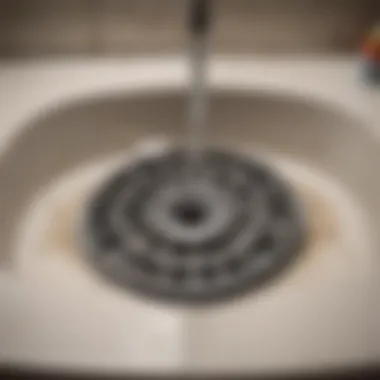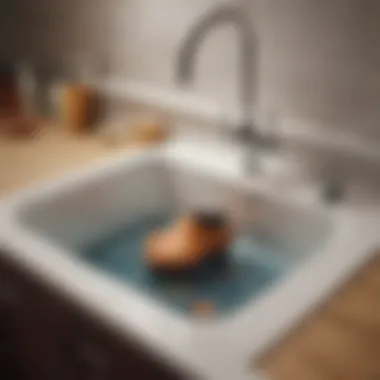Understanding Kitchen Sink Clogs: Causes and Solutions


Intro
Kitchen sink clogs are a common issue that many homeowners face. Understanding the reasons behind these clogs, preventing them before they occur, and knowing how to resolve them can save time and money. Clogs can be caused by various factors, including food debris, grease buildup, and foreign objects. With this knowledge, homeowners can maintain their kitchens more effectively.
In this guide, we will cover the causes of kitchen sink clogs, practical prevention strategies, and effective solutions for dealing with blockages. Moreover, we will connect the functionality of the sink to wider interior design and architectural choices. By addressing these elements, homeowners can enjoy both a well-functioning kitchen and an aesthetically pleasing environment.
Architectural Inspiration
A well-designed kitchen does not just focus on functionality; it also embodies style and elegance. This section examines design inspirations and materials that can complement kitchen spaces, especially in relation to sink choice and organization.
Overview of Design Styles
When it comes to choosing a kitchen style, options range from rustic farmhouse to modern minimalism. Each style influences how sinks and their functionalities fit into the overall aesthetic. For instance, in a farmhouse kitchen, a deep, apron-front sink can serve as a statement piece, while in a minimalist kitchen, an under-mount sink can provide a seamless look with the countertop.
Innovative Materials and Techniques
Materials play a vital role in sink durability and maintenance. Stainless steel is one of the most popular choices for its resistance to stains and corrosion. Composite sinks made from quartz or granite dust offer a modern look and improved resistance to scratches and chipping. Installation techniques like the use of double-basin sinks can enhance utility, allowing for efficient dishwashing and food prep, reducing the chances of clogs.
"Choosing the right sink material and style can greatly influence maintenance and clog prevention strategies."
Incorporating these innovative designs and materials not only elevates the kitchen’s appearance but also addresses practical concerns such as clogs and maintenance. By understanding these elements, homeowners can enhance both functionality and style.
Preface to Kitchen Sink Clogs
Kitchen sink clogs represent a common yet often underestimated challenge in household maintenance. Many homeowners overlook the potential for clogs, not realizing the impact these can have on daily life. Understanding the elements that contribute to kitchen sink clogs is crucial for effective management and prevention. Addressing these clogs not only saves time and frustration but also prolongs the life of plumbing systems and fixtures.
What Constitutes a Clog
A clog occurs when the flow of water through a sink becomes interrupted, causing it to back up. This can happen for several reasons. The most typical causes involve the accumulation of food particles, grease, and foreign objects that obstruct the drain. Over time, these materials can form a solid mass, which water cannot penetrate easily. Additionally, mineral build-up from hard water can exacerbate clogging, as deposits narrow the pipe's diameter.
In technical terms, a clog is often the result of both physical and chemical interactions within the plumbing. It is not solely the presence of a blockage, but also how these materials adhere to pipe surfaces. The type of pipes used also plays a role. For instance, older pipes may corrode and create smaller openings, increasing the risk of blockage. Recognizing what constitutes a clog empowers homeowners to tackle issues before they escalate.
The Importance of Addressing Clogs Promptly
Addressing clogs promptly is essential for several reasons. First, as a clog worsens, it can lead to larger plumbing issues, including pipe damage or leaks. These problems can incur significant repair costs, which may easily surpass what is spent on routine maintenance.
Second, prolonged clogs can create a breeding ground for bacteria. Stagnant water introduced by a clog can foster unpleasant odors and potentially lead to health hazards within the household.
It is also important to consider the inconvenience of a clogged sink. Cooking and cleaning become increasingly cumbersome as sink functionality decreases. Prompt attention to clogs reduces disruption to daily activities.
To summarize, understanding kitchen sink clogs, their causes, and the importance of addressing them quickly is a pivotal aspect of home maintenance. This knowledge not only reinforces the aesthetic and functional integrity of kitchen space but also prevents larger, more costly issues down the road.
Clogs in kitchens can become a significant problem if not dealt with quickly and efficiently. By being proactive, homeowners can maintain a functional and hygienic kitchen.
In the upcoming sections, we will delve into the common causes of kitchen sink clogs, explore preventive measures, and discuss both DIY solutions and when to call for professional help.
Common Causes of Kitchen Sink Clogs
Understanding the common causes of kitchen sink clogs is essential for effective home maintenance. Identifying these causes allows homeowners to implement preventive measures before clogs escalate into larger issues. Over time, clogs can lead to unpleasant odors, slow drainage, and even plumbing emergencies. This section examines the specific factors contributing to clogs.
Food Particles and Residue
Food particles and residue are often the primary culprits behind kitchen sink clogs. When food is washed down the drain, small bits may accumulate in the plumbing. Over time, these remnants can adhere to the pipe walls, leading to significant blockages. This issue is particularly prevalent with hard-to-break-down foods such as rice, pasta, and fibrous vegetables. To mitigate this, it is advisable to scrape plates before washing, ensuring that large food particles do not enter the drain.


Grease and Fats Accumulation
Another common cause of clogs relates to the accumulation of grease and fats. Many homeowners dispose of cooking oils, butter, and other fats by pouring them down the sink. As these substances cool, they solidify and can create stubborn blockages. Regular exposure to heat can keep grease in liquid form, allowing it to pass through pipes, but once it cools, it can cling to the walls of the plumbing. Therefore, it is crucial to avoid pouring fats down the drain and instead opt for disposal in a container.
Foreign Objects and Debris
Foreign objects and debris can also cause significant kitchen sink clogs. Items such as utensils, small toys, or even food packaging can accidentally find their way into the sink. These foreign bodies can lead to unexpected blockages, halting drainage. Homeowners should be mindful of what is placed near the sink area. Installing a proper drain cover can help minimize the risk of larger items entering the plumbing system and should be considered a best practice for any kitchen.
Improper Waste Disposal Practices
Improper waste disposal practices contribute significantly to kitchen sink clogs. Many individuals tend to treat their sinks as trash disposal systems, leading to consequences. It's important to understand the limitations of kitchen sink waste systems. Disposing of non-biodegradable items or inappropriate food waste can result in severe plumbing issues. Adopting responsible disposal habits and educating household members on proper practices will help maintain a clear and functioning drainage system.
How to Properly Maintain Your Kitchen Sink
Maintaining your kitchen sink is crucial for ensuring efficient drainage and prolonging the lifespan of your plumbing system. Regular maintenance helps prevent clogs and expensive repairs, providing a more enjoyable cooking experience. It also reflects on the overall cleanliness and hygiene of your kitchen, which is important for any home.
Regular Cleaning Routines
Establishing a routine for cleaning your kitchen sink can significantly reduce the likelihood of clogs. This involves scrubbing the sink with a mild detergent and hot water regularly. Using a sponge or cloth can help remove stains and buildup. Pay particular attention to the drain, as residual food particles can accumulate, leading to blockages.
Additionally, consider using a mixture of baking soda and vinegar once a week to sanitize your sink and break down potential buildup inside the pipes. Pouring this mixture down the drain allows it to work its way through the plumbing while neutralizing odors and clearing minor debris.
Use of Drain Screens
Implementing drain screens is a simple and effective method to maintain your kitchen sink. These screens capture food particles and debris before they enter the drain. They prevent larger items from causing clogs and can be easily cleaned or replaced.
By using drain screens, you will significantly reduce the amount of waste that actually reaches your plumbing system. This simple tool not only saves you time and effort in the long run but also acts as a barrier against larger blockages.
Flushing the Drain Periodically
Flushing the drain periodically serves as a proactive measure to keep it clear. Using hot water to flush the drain can help dissolve grease or any other residues that may be lingering. Simply running hot water for a few minutes after using the sink can help wash away leftover particles and lessen the chances of clogs.
For more thorough flushing, consider using a diluted bleach solution once a month. This mix will help eliminate bacteria and further reduce any odor that may develop over time.
Monitoring Sink Usage
Being mindful of what goes down your kitchen sink is a critical element of maintenance. Certain substances, like grease, coffee grounds, and fibrous foods, can contribute to clogs if routinely disposed of in the sink. Understanding and recognizing the waste types that should not enter the drain can be beneficial.
Encourage your household to adopt better waste disposal practices. For example, use a compost bin for food scrap disposal and designate a bin for grease collection instead of pouring it down the sink. This mindfulness can make a significant difference in the longevity and functionality of your plumbing system.
Regular maintenance not only prevents clogs but also enhances your kitchen's overall hygiene and efficiency.
Recognizing Warning Signs of a Clog
Recognizing the warning signs of a clog is crucial for keeping your kitchen sink in optimal condition. Identifying these signs early can prevent larger issues, saving both time and money. When a clog develops, it can lead to further complications in drainage and plumbing systems. Thus, understanding these indicators is central to effective home maintenance.
Slow Drainage
One of the most common signs of a potential clog is slow drainage. When water takes longer than usual to flow down the sink, it may indicate an obstruction within the pipes. This can start as a minor inconvenience but can quickly escalate into a more serious problem.
Factors that contribute to slow drainage include:
- Accumulation of food particles.
- Grease buildup along the pipes.
- Foreign objects lodged in the drainage system.


Homeowners should monitor their sinks routinely. Taking note of drainage speed can allow for prompt action before a minor issue develops into a significant blockage.
Unpleasant Odors
Unpleasant odors emanating from the sink can be an often overlooked signal of a clog. These smells arise due to trapped food particles and stagnant water breaking down, which is not only unpleasant but can pose health risks as well.
Some steps to address and investigate these odors include:
- Inspecting the sink for any visible signs of residue.
- Flushing the drain with hot water.
- Using a solution of baking soda and vinegar to help break down buildup.
If odors persist despite these efforts, it may indicate a more severe clog that requires further inspection.
Gurgling Sounds
Gurgling sounds coming from the sink can also serve as a red flag. These noises typically occur as air escapes from blockages in the plumbing system. When water cannot flow freely, it creates air pockets that produce these gurgling sensations.
This can be frustrating and alarming to homeowners, and ongoing gurgling should not be ignored. It may not only indicate that a clog is present but also suggest that issues exist deeper within the plumbing network.
Recommendations for handling gurgling sounds include:
- Conducting a thorough check of the sink and surrounding pipes.
- Listening carefully to pinpoint when the sounds occur.
- Seeking professional help if these problems continue.
Understanding these warning signs can empower homeowners, helping them maintain their kitchen sink and avoid costly repairs.
DIY Solutions for Minor Clogs
Addressing kitchen sink clogs can often be a straightforward task for homeowners, particularly when it comes to minor issues. Implementing DIY solutions not only saves time but also reduces the need for professional intervention in many cases. Furthermore, using basic tools and household items can make the experience cost-effective.
From preventing minor clogs from escalating to troubleshooting issues quickly, understanding various DIY solutions is essential. Readers will benefit from mastering these techniques, gaining confidence in managing their home’s plumbing system.
Plunger Techniques
The plunger remains a staple tool for resolving clogs. Its effectiveness relies on creating pressure and suction to dislodge blockages. When using a plunger, a few steps are vital. First, it is important to ensure that enough water fills the sink to cover the bell of the plunger. This helps create suction.
Place the plunger over the drain and press down firmly before pulling up quickly. Repeat this process several times while ensuring a tight seal. After a few vigorous attempts, the clog should start to loosen. This simple method alleviates many minor clogs without resorting to harsh chemicals or complicated processes.
Baking Soda and Vinegar Method
A combination of baking soda and vinegar is another effective method for handling minor clogs. This approach is not only safe for the environment but also can be quite satisfying to execute. First, add half a cup of baking soda directly into the sink drain. Follow this with half a cup of vinegar. The mixture generates a fizzing action that can help break down grime and debris.
Let this sit for around 30 minutes before flushing with hot water. This method is particularly effective against grease buildup and food particles, making it a favored choice among homeowners looking for eco-friendly cleaning solutions.
Manual Removal of Blockages
In cases where the clog is particularly stubborn, manual removal might be required. Begin by using a drain snake or a simple coat hanger. It is crucial to ensure that any cleaning tools used remain safe for pipes. To facilitate access, remove the sink stopper, if possible, and carefully insert the snake or hanger to dislodge debris.
Another technique involves wearing rubber gloves and manually reaching down the drain. This can be effective in pulling out larger clumps of food or other blockages. If at any point there is resistance, stop and reassess to avoid damaging the plumbing.
Using DIY methods can significantly extend the lifespan of plumbing systems and reduce repair costs.
Each of these DIY solutions provides homeowners with practical tools to combat minor clogs. The effectiveness of these methods emphasizes the importance of being vigilant about sink maintenance.
When to Call a Professional


Recognizing when to seek professional help for kitchen sink clogs is crucial for effective problem resolution. While some clogs can be efficiently managed using DIY methods, others require the expertise of a professional plumber. Knowing the right moment to call for assistance can save you time, money, and potential damage to your plumbing system.
Persistent Clogs
If a clog recurs frequently despite your best efforts to clear it, it may indicate a deeper problem within your plumbing. Persistent clogs can point to several issues, including:
- Misaligned pipes: Over time, pipes can shift or become dislodged, causing recurring blockages.
- Tree root intrusion: Roots infiltrating sewer lines can create formidable clogs.
- Underlying build-up: Accumulated debris that cannot be addressed through standard cleaning methods may exist.
Engaging a professional ensures a thorough diagnosis and rectification of the issue. They possess specialized tools and methods to identify and clear persistent clogs that a homeowner may overlook.
Uncertain Causes
Sometimes, the root cause of a clog is not easily identifiable. Whether due to unusual plumbing configurations or unexpected materials causing blockage, uncertain causes can complicate the situation. If you find yourself unable to identify why your kitchen sink is clogged, it is advisable to seek professional help. A plumber can conduct a detailed inspection, possibly using camera technology to visualize the interior of the pipes. This precision can help identify:
- Foreign objects lodged in the drain.
- Hidden leaks: Undetected leaks can contribute to clogging and may require immediate attention to prevent further issues.
Potential Plumbing Issues
Not all clogs are isolated incidents; some may indicate broader plumbing issues. Signs that suggest potential plumbing problems include:
- Frequent overflow events: If multiple sinks or fixtures are involved, this may indicate systemic issues within your plumbing.
- Strange noises: Gurgling or bubbling sounds can suggest a blockage in the vent system, impacting drainage.
If you suspect plumbing issues beyond a simple clog, it is wise to contact a professional. They can provide insights and repairs that ensure the longevity and efficiency of your plumbing system. Remember, addressing problems early can prevent costly repairs in the future.
Exploring Alternative Drainage Solutions
Exploring alternative drainage solutions is essential for homeowners who want to enhance their kitchen's efficiency and prevent clogs. By understanding the available options, individuals can make informed decisions that not only improve functionality but also maintain the aesthetics of their kitchen. Adopting alternative drainage solutions can provide various benefits, including reduced clogs and easier maintenance.
Installing a Garbage Disposal
Installing a garbage disposal is an effective method to minimize kitchen sink clogs. This appliance grinds food waste into smaller pieces, allowing them to flow easily through the plumbing system. Here are some specific advantages of having a garbage disposal:
- Reduces Food Waste: Instead of placing food scraps in the trash, they can be disposed of via the sink, promoting a cleaner kitchen environment.
- Decreases Clog Potential: By pulverizing food waste, you lower the chances of large particles blocking your drainage.
- Convenient Cleanup: After cooking or dining, cleaning becomes simpler with a garbage disposal. Just turn on the device while running water.
However, certain considerations must be taken into account. Proper installation is critical. If the disposal is not installed correctly, it can lead to leaks or improper functioning. Additionally, not every food type is suitable for disposal. Items like fibrous vegetables or grease can still cause issues, so it’s important to understand what can safely go down the drain.
Upgrading Drainage Systems
Upgrading drainage systems stands as another viable alternative for handling kitchen sink clogs. Aging or poorly designed systems may struggle to manage modern kitchen demands. Opting for a system that accommodates larger waste flows can significantly reduce the likelihood of clogs. Benefits of an upgraded drainage system include:
- Improved Flow Capacity: A well-designed system provides better drainage, accommodating both food waste and other debris without obstruction.
- Enhanced Durability: Newer materials and designs are often more resistant to corrosion and wear, presenting long-term advantages over older systems.
- Potential for Better Maintenance: Modern systems can come with features such as clean-out access points, allowing for easier maintenance and inspection when issues arise.
"Investing in alternative drainage solutions is not just about today, but about ensuring long-term efficiency and functionality of your kitchen."
The End
Kitchen sink clogs present a significant inconvenience that homeowners often overlook until a problem arises. This article has explored essential aspects surrounding kitchen sink clogs, shedding light on their causes, prevention strategies, and practical solutions. The importance of understanding these factors cannot be emphasized enough, as timely and effective management can save both time and expense while maintaining a functional household.
Summary of Key Points
In summary, we addressed various common causes of kitchen sink clogs such as food residues, grease accumulation, and foreign objects. We also highlighted the significance of regular maintenance routines to prevent these issues from escalating. Key takeaways include:
- Awareness of clog causes: Knowing what typically leads to clogs empowers homeowners to take precautionary measures.
- Regular maintenance: Simple practices such as using drain screens and flushing drains can drastically reduce occurrences of clogs.
- Recognizing warning signs: Identifying early symptoms like slow drainage or unpleasant odors facilitates prompt action, potentially avoiding larger problems.
Final Thoughts on Maintenance and Clog Prevention
Overall, maintaining a healthy kitchen drainage system is vital not just for functionality but also for the enjoyment and aesthetic of your kitchen space. By establishing a consistent maintenance plan and being vigilant about what goes down the drain, homeowners can significantly minimize the risk of clogs.
Being proactive is more beneficial than being reactive. The small effort spent on routine checks and adherent practices can lead to a better kitchen experience. Thus, integrating these practices into your home routine will bring both functionality and peace of mind.







